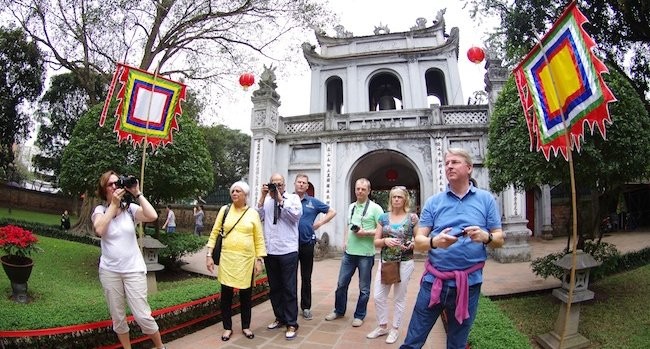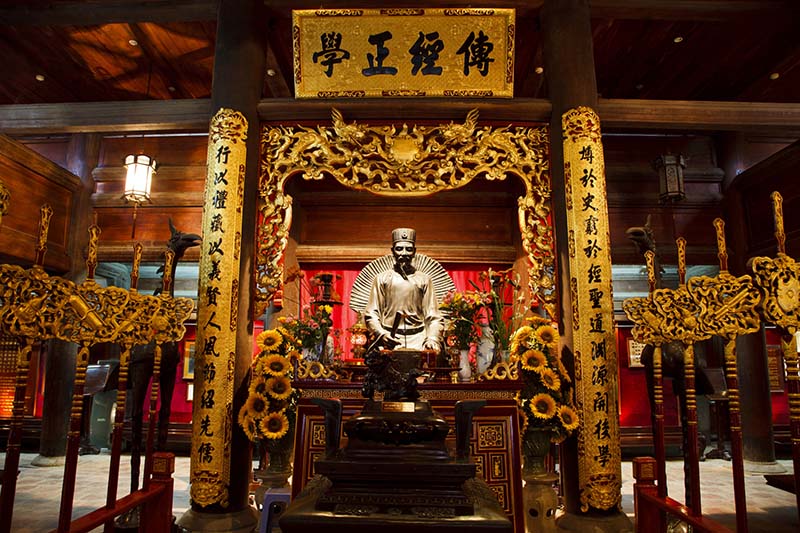A Historical Tapestry:
Dating back to the 11th century, the Temple of Literature was founded during the reign of Emperor Ly Thanh Tong. Its original purpose was to honor Confucius, the Chinese philosopher whose teachings formed the basis of Vietnam's educational system. Over time, the temple evolved into Vietnam's first national university, serving as a center of learning for scholars and students alike. As the centuries passed, the Temple of Literature evolved from a humble shrine into a prestigious center of learning, earning the distinction of being Vietnam's first national university. Within its hallowed halls, scholars and students gathered to study the classical texts of Confucianism, literature, poetry, and the arts. Under the watchful gaze of statues depicting Confucius and his disciples, they engaged in rigorous intellectual pursuits, striving for academic excellence and moral virtue.
The temple became a beacon of enlightenment, attracting scholars from across the country who sought to master the teachings of Confucius and compete in the rigorous examinations held within its walls. These examinations, known as the "Imperial Examinations," were a cornerstone of Vietnam's educational system, serving as a pathway to success and social mobility for those who demonstrated exceptional scholarship and talent.

Architectural Marvels:
The architecture of the Temple of Literature reflects the elegance and sophistication of traditional Vietnamese design. As visitors pass through its ornate gates, they are greeted by a series of courtyards, pavilions, and tranquil gardens, each meticulously designed to inspire contemplation and reverence. The centerpiece of the complex is the Van Mieu Gate, a majestic structure adorned with intricate carvings and inscriptions. Beyond the gate lies the Courtyard of the Sage, flanked by rows of stone steles mounted on the backs of tortoises. These steles bear the names of scholars who passed the rigorous examinations held at the temple during the Ly and Tran dynasties, immortalizing their achievements for future generations. As visitors approach Van Mieu, they are greeted by a series of imposing gateways, each meticulously crafted to convey a sense of grandeur and reverence. The main entrance, known as the Van Mieu Gate, features intricate carvings and ornate details that symbolize the importance of education and scholarship. Flanked by two smaller gates, the Van Mieu Gate serves as a symbolic threshold, inviting visitors to enter into a realm of knowledge and enlightenment.
Beyond the gateways lie a series of tranquil courtyards, each designed to evoke a sense of serenity and contemplation. The Courtyard of the Sage, the largest and most central courtyard, is bordered by a series of pavilions and altars dedicated to Confucius and his disciples. Here, visitors can pause and reflect amidst meticulously manicured gardens, elegant pagodas, and graceful lotus ponds, immersing themselves in the timeless beauty of Vietnam's architectural heritage. One of the most distinctive features of Van Mieu is its collection of stone stelae, which are mounted on the backs of stone tortoises and arranged in rows throughout the complex. These stelae, inscribed with the names of scholars who passed the rigorous examinations held at the temple during the Ly and Tran dynasties, serve as a tangible reminder of Vietnam's rich intellectual tradition. Each stele represents a triumph of scholarship and dedication, honoring those who achieved academic excellence and earned the respect of their peers. Scattered throughout the courtyards of Van Mieu are a series of pavilions and halls, each adorned with intricate carvings, vibrant murals, and elegant architectural details. These structures served as classrooms, lecture halls, and meeting places for scholars and students, providing a sanctuary for intellectual exchange and debate. The architecture of these pavilions reflects the sophistication and refinement of traditional Vietnamese design, showcasing a mastery of woodwork, stonemasonry, and decorative arts.
.jpg)
For centuries, the Temple of Literature has been a revered symbol of learning and culture in Vietnam. It has served as a place of pilgrimage for scholars, students, and educators, who come to pay homage to the teachings of Confucius and seek inspiration for their own academic pursuits. Today, the temple continues to play a vital role in Vietnamese society, hosting cultural events, academic ceremonies, and celebrations of scholarship. From its origins as a center of Confucian learning to its enduring legacy as a national treasure, Van Mieu holds a special place in the hearts of the Vietnamese people and serves as a beacon of cultural pride and historical continuity. At its core, Van Mieu embodies the enduring values of Confucianism, which have played a central role in shaping Vietnamese society for over a millennium. As the first national university of Vietnam, the temple served as a bastion of Confucian scholarship and moral instruction, instilling in generations of students a deep reverence for learning, ethics, and social harmony. Its teachings emphasized the importance of filial piety, respect for authority, and the cultivation of virtuous character, principles that continue to resonate with Vietnamese culture to this day.
Throughout its long and storied history, Van Mieu has been a place of pilgrimage for scholars, students, and intellectuals, who come to pay homage to the great minds of the past and seek inspiration for their own academic pursuits. The temple's famous stone stelae, inscribed with the names of scholars who passed the imperial examinations, serve as a tangible testament to the achievements of Vietnam's intellectual elite and the importance of education in Vietnamese society. By honoring the accomplishments of these scholars, Van Mieu reinforces the idea that knowledge is the key to personal advancement, social mobility, and national prosperity. As one of the oldest and most well-preserved examples of traditional Vietnamese architecture, Van Mieu serves as a living link to the country's rich cultural heritage. Its elegant pavilions, tranquil courtyards, and graceful gardens provide a sanctuary from the hustle and bustle of modern life, allowing visitors to connect with the timeless beauty and wisdom of the past. By preserving and maintaining the temple's architectural treasures, Vietnam reaffirms its commitment to safeguarding its cultural legacy for future generations and ensuring that the lessons of history are not forgotten.
.jpg)
Exploring the Temple:
Visitors to the Temple of Literature can immerse themselves in its rich history and cultural significance through guided tours and educational exhibits. They can wander through the tranquil gardens, admire the architecture of the pavilions and altars, and gain insight into the rituals and traditions that have shaped Vietnam's intellectual heritage.

Preserving the Legacy:
Efforts are ongoing to preserve and protect this invaluable piece of Vietnam's heritage for future generations to cherish and enjoy. Van Mieu holds a special place in the hearts of the Vietnamese people as a symbol of national pride and unity. Its designation as a UNESCO World Heritage Site in 2010 was a testament to its universal significance and the importance of preserving its cultural legacy for the benefit of all humanity. Today, the temple continues to inspire awe and admiration among visitors from around the world, serving as a source of inspiration and pride for the Vietnamese people and a reminder of their rich cultural heritage.

The Temple of Literature stands as a testament to Vietnam's enduring commitment to learning, scholarship, and cultural preservation. As visitors explore its hallowed halls and peaceful gardens, they are transported back in time to an era when knowledge was revered above all else. In a world that is constantly changing, the Temple of Literature serves as a reminder of the timeless values that unite us all – the pursuit of wisdom, the celebration of culture, and the quest for enlightenment.
𝑆ℎ𝑜𝑢𝑙𝑑 𝑦𝑜𝑢 𝑛𝑒𝑒𝑑 𝑎𝑛𝑦 𝑓𝑢𝑟𝑡ℎ𝑒𝑟 𝑖𝑛𝑓𝑜𝑟𝑚𝑎𝑡𝑖𝑜𝑛 𝑎𝑏𝑜𝑢𝑡 𝑉𝑖𝑒𝑡𝑛𝑎𝑚 𝑣𝑖𝑠𝑎 𝑜𝑟 𝑉𝑖𝑒𝑡𝑛𝑎𝑚 𝑣𝑎𝑐𝑎𝑡𝑖𝑜𝑛𝑠, 𝑓𝑒𝑒𝑙 𝑓𝑟𝑒𝑒 𝑡𝑜 𝑐𝑜𝑛𝑡𝑎𝑐𝑡 𝑢𝑠 𝑎𝑡 +𝟖𝟒.𝟗𝟎𝟑.𝟐𝟕𝟖.𝟖𝟓𝟑 𝑂𝑟 𝑒𝑚𝑎𝑖𝑙 𝑢𝑠 𝑎𝑡 𝐬𝐮𝐩𝐩𝐨𝐫𝐭@𝐠𝐨𝐯𝐢𝐞𝐭𝐧𝐚𝐦𝐯𝐢𝐬𝐚.𝐜𝐨𝐦, 𝑜𝑢𝑟 𝐶𝑢𝑠𝑡𝑜𝑚𝑒𝑟-𝐶𝑎𝑟𝑒 𝐶𝑜𝑛𝑠𝑢𝑙𝑡𝑎𝑛𝑡𝑠 𝑤𝑖𝑙𝑙 𝑟𝑒𝑠𝑝𝑜𝑛𝑑 𝑤𝑖𝑡ℎ𝑖𝑛 2 ℎ𝑜𝑢𝑟𝑠 𝑑𝑢𝑟𝑖𝑛𝑔 𝑤𝑜𝑟𝑘𝑖𝑛𝑔 𝑡𝑖𝑚𝑒 (𝑉𝑖𝑒𝑡𝑛𝑎𝑚 𝑡𝑖𝑚𝑒 𝐺𝑀𝑇+7).
Related reading
- Researching entry and exit procedures through facial recognition for foreign tourists
- Khai Dinh Tomb Hue - The pinnacle of mausoleum architecture in the Nguyen Dynasty
- Vietnam needs cooperate with more international airlines to improve both aviation and tourism
- Govietnamvisa service all cover for the first time visitors
- Automatic immigration gates facilitate passengers' travel
- Some useful notes for Vietnam Travel Insurance you should know
Or kindly read our FAQs, live Questions, or our General Vietnam Visa Information.









